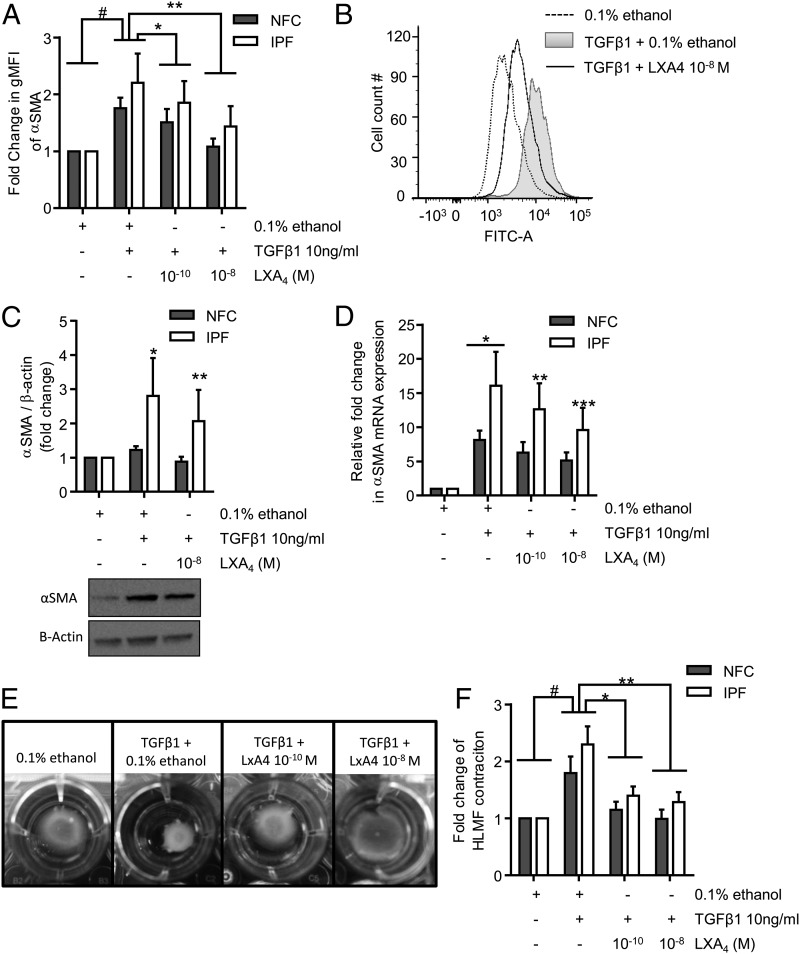FIGURE 4.
TGF-β1–dependent increases in αSMA mRNA and protein expression and HLMF contraction are attenuated by LXA4. (A) Flow cytometry was used to assess the changes in αSMA expression following TGF-β1 (10 ng/ml) stimulation in the presence of LXA4, in both NFC- (n = 4) and IPF-derived (n = 3) HLMFs. αSMA expression in HLMFs was significantly increased following TGF-β1 stimulation (#p = 0.0070, paired t test). LXA4 significantly attenuated TGF-β1–dependent increases in αSMA expression at 10−10 and 10−8 mol (*p = 0.011 and **p = 0.008, respectively; repeated-measures ANOVA corrected by Sidak multiple-comparison test, statistics were performed on pooled data). (B) Representative fluorescent histogram showing αSMA expression in HLMFs under the above conditions. (C) Densitometry results of Western blot analysis indicating the increased αSMA expression following TGF-β1 (10 ng/ml) stimulation for 24 h in IPF donors (*p = 0.0344, paired t test). This increase was significantly attenuated by LXA4 10−8 mol (**p = 0.0274, paired t test). No significant difference was found between NFC- and IPF-derived HLMFs in terms of TGF-β1–stimulated αSMA expression (p = 0.25). (D) Quantitative PCR results displaying the relative expression of αSMA in HLMFs following 24 h of stimulation with TGF-β1 (10 ng/ml) in the presence of 0.1% ethanol or LXA4 at 10−10 and 10−8 mol. TGF-β1 significantly upregulated αSMA mRNA expression in both NFC- (n = 6) and IPF-derived (n = 5) HLMFs (p = 0.018, one-sample t test). IPF-derived HLMFs demonstrated a significantly greater increase in mRNA expression in comparison with NFC-derived cells (*p = 0.0261). TGF-β1–dependent upregulation of αSMA mRNA expression was significantly inhibited in IPF-derived cells in the presence of LXA4 10−10 and 10−8 mol (**p = 0.0479, ***p = 0.0033, respectively, two-way ANOVA, corrected by Sidak multiple-comparison test). (E) Representative images from an IPF donor showing the TGF-β1–stimulated contraction of HLMFs within a collagen gel and its suppression by LXA4. (F) HLMFs from both NFC- (n = 6) and IPF-derived (n = 5) donors displayed increased contraction following TGF-β1 (10 ng/ml) stimulation (#p = 0.0026, one-sample t test, pooled data). LXA4 significantly attenuated HLMF contraction in both NFC- (n = 6) and IPF-derived (n = 5) myofibroblasts at 10−10 and 10−8 mol (p = 0.0005, repeated-measures ANOVA, *p = 0.0057, **p = 0.0006, corrected by Dunn multiple-comparison test).

